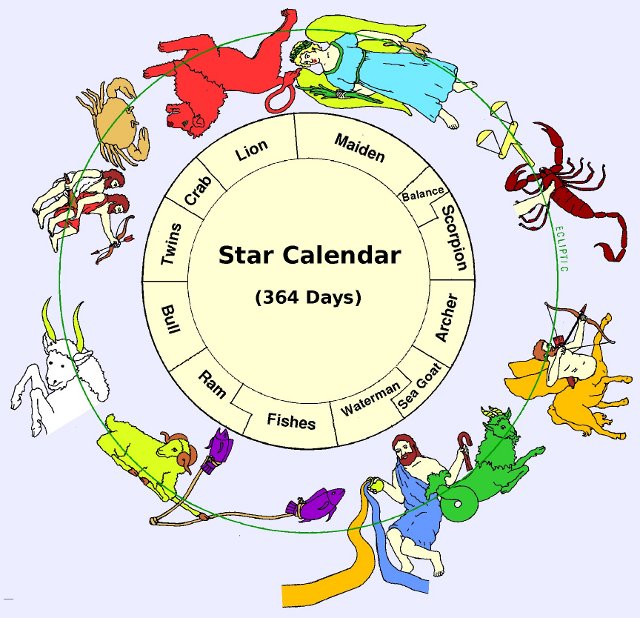
by John P. Pratt
20 Apr 2018: For Leah: Princess (S); For Rebekah 1 Res (M);
For Sarah: 1 Deer (SR), 1 Adult (UMa), Upward (US).
©2018 by John P. Pratt. All rights Reserved.
| 1. Star Calendar |
| 1.1 Overview |
| 1.2 Precession and Passover |
| 2. Twins |
| 2.1 Leah & Rachel |
| 2.2 Zebulon & Dinah |
| 2.3 Manasseh & Ephraim |
| 3. Conclusion |
| Notes |
For decades it has been known in my work in sacred calendars that the Sacred Round, Venus Calendar and (Perpetual) Hebrew Calendar are important for birth and death dates, but that other calendars are used for other purposes. The Star Calendar was only discovered last year and it was not immediately obvious what its use is. Now further research indicates that it is not only used for birth dates, but that twins can be born on different star days for meaningful reasons. Like the other birth calendars, these star dates can be used to link them to family members born on the same stars days.
This article discusses newly proposed times of day for the proposed births of three important sets of twins from the book of Genesis: Leah & Rachel, Zebulon & Dinah, and Manasseh & Ephraim. Evidence is presented that the two members of each pair apparently were born on different star days and discusses reasons why that might have been.
The Star Calendar is discussed in detail in an earlier article,[1] so only the important features necessary to understand for this article are presented here. In fact, if you wish to skip even this somewhat technical discussion, all you really need to know is that each day of the year is assigned to a different star and that the star day begins at noon.
 |
Star days are all assigned to one of the twelve zodiac constellations which all are found around the ecliptic circle in the sky. Thus, star days are similar to the astrological idea that it is important to know in which zodiac constellation the sun appeared to be at the time of one's birth. An important difference from astrology, however, is that star days are assigned according to where the sun is actually found on the ecliptic among zodiac figures over very different lengths (see Figure 1). In astrology each figure is assigned about 30 days, but the Star Calendar only gives the little constellation of the Crab (Cancer) 2 weeks whereas the Maiden (Virgo) has 7 weeks of the year.
Not only does the Star Calendar year always begin on a Sunday, each of the zodiac divisions also begins on a Sunday and lasts for an exact number of weeks. The 52-week year of 364 days has an extra week inserted every few years between the Lion (Leo) and the Maiden (Virgo) to increase the average year length to equal the true star (sidereal) year. It should be noted that a star year is slightly longer than the usual seasonal (tropical) year so that the constellation in which the sun is found on the first day of spring changes about every 2,000 years. Thus, the Star Calendar is in that way independent from all of the other sacred calendar cycles.
There is also a Uniform Star Calendar (US) which always has 364 days and never inserts an extra week. This calendar does not actually track the stars but is useful to connect a star with a given date without requiring the sun to actually be in that area. Thus, any star day could occur at any time during the year, provided that it always falls on the same day of the week as on the regular Star Calendar.
Each star day can be designated in five different ways. First, every day is numbered as to what day it is in its associated zodiac figure. For example, the bright star which is the left foot of Orion is designated "29 Tau", meaning that when its longitude is projected down onto the ecliptic that it falls into the 29th day after the sun has entered the constellation of the Bull (Taurus). Three letter abbreviations are used for the Latin names of each zodiac figure. Thus "1 Vir" means the Sunday usually nearest to when the sun enters the constellation of the Maiden (Virgo).
A second designation is the one used by astronomers to refer to a star. Orion's left foot is called β Ori, meaning its Greek designation in the constellation the Hunter, Orion (Ori). For those who skipped Greek in school, the third way to refer to the star is by abbreviating the Greek letter ("beta" in this case) in English with three letters: Bet Ori.
The fourth way to refer to the star is by its proper name which is usually in Arabic, Latin or Greek. The proper name of the star in the Hunter's left foot is Rigel. That is the most common way for astronomers to refer to a star if it indeed has a proper name, which only applies to the brightest stars. In my work, names have been given to some of the dimmer stars in either Arabic, Greek or Latin, just for ease in referring to them.
The fifth way to refer to the stars by its English name given in my work. Sometimes that is an actual translation of the usual name and other times it a religious name based on the sacred meaning of the star. Thus, my name for Rigel, which comes from the Arabic for "left leg", is "Fulness" because that name suggests something near maximum brightness, even as Fulness is used in the Venus Cycle for when the planet is brightest in the morning sky.
Hopefully that is all of the information needed to understand the rest of this article. If the reader did not understand all of that, the main idea is that there is a star associated with every day (beginning at noon) of the year!
There are two more features of the star calendar which need to be understood. Because of what is called "precession" the star year varies slightly from our regular seasonal year. The effect is very slow. If the sun rises on the first day of spring in a certain constellation, such as the Ram (Aries), then after about 2,000 years it will rise in the next constellation counterclockwise from that in Figure 1, namely the Fishes (Pisces). The cause of the precession is discussed in an earlier article.[2]
There is another feature of the Star Calendar which has not been discussed in any former article which is now needed. On other sacred calendars based on the week there is a correspondence between holy days. That is, the holy week of Passover on the (Perpetual) Hebrew Calendar corresponds to the 7-day Mid-year Fest on the Jubilee Calendar and to Passover week on the Enoch Calendar.
In the time of Adam (4000 BC), Passover occurred when the sun was in the stars of the Twins (Gemini). By the time of Abraham (2,000 BC) Passover was when the sun appeared to be the Bull (Taurus). At the time of Christ (1 BC) the sun was in Aries at Passover. In our day the sun is in the Fishes (Pisces).
It turns out that all four of those constellations have two fairly bright stars about a week apart in how long it takes the sun to pass them. Moreover, those stars also just happen to be very near to days 15 and 22 counting from the first star of the constellation encountered by the sun. Thus, it is a perfect set up to have the seven days of Passover correspond to those seven star days, at least at some time when they do in fact actually coincide.
The Hebrew Passover week (also called Unleavened Bread) always falls on the seven days from 15-21 Nisan (the first spring month). The date of the Hebrew Easter (Waving of the Omer) always falls on the Sunday after Passover day (15 Nisan). In years when New Year's Day (1 Nisan) falls on a Sunday, Easter occurs on 22 Nisan.
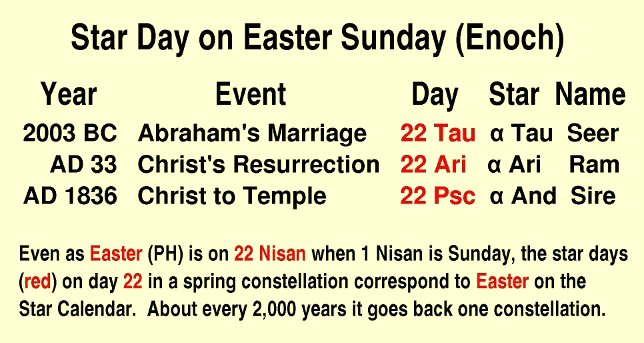 |
As for Easter, it is usually an even brighter star on day 22 of those same months at those different dates, even as the Hebrew Easter is on the day 22 Nisan in similar years. Table 1 uses Easter Sunday on the Enoch Calendar because it only has a range of about 3 Apr to 13 Apr, rather than a full month as on our Gregorian Calendar (from 22 Mar to 23 Apr). If Easter is always on a Sunday, it has to have a range of at least a week in the solar year. Table 1 lists events on three Easter Sundays on the Enoch Calendar that happened about 2,000 years apart. These are events found in my Religious Chronology which have been published previously. The point of the table is not only some important events happened when the Enoch Easter coincided with the Star Calendar Easter, but the constellation changed from Taurus to Aries to Pisces!
This article resulted from me going carefully through my Religious Chronology web page filling in important star days for many of the entries. Rather than have me write an extensive article about all of the star days for all 200+ entries on that list, the reader can simply look up dates of interest and find links to events which occurred on those star days. By clicking on the English star names there, which are the default designation, one can cycle through all five identification methods described above so that it will be clear what star is being referenced.
As that work was being done, when I came to the twins Ephraim and Manasseh, it suddenly became clear that in order to fulfill scripture they must have been born on different star days with Manasseh before noon and Ephraim afterwards. Then the same thing happened with Zebulon and Dinah, which led me to then look at Leah and Rachel. I had never seen any indication of them not having been born on the same day on all of the sacred calendars. For me to publish anything, two witnesses are required and suddenly two witnesses appeared for those two sisters also. Thus, let us look at each of these three cases in more detail in order to appreciate the amazing timing on the Lord's sacred calendars!
The Bible does not mention that Jacob's wives Leah and Rachel were twins, but it is explicitly stated in the Book of Jasher (Jasher 28:28). That could help explain why Jacob did not know he was being married to the wrong sister!
 |
Here are the two witnesses that Rachel was born after noon. We know Leah was the older twin because that was the reason given for having her marry Jacob first. If Rachel was born in the afternoon of their birth date on Sat 2 Mar 1836 BC, then the star day would be "Anointed" (Mesarthim, γ Ari, Gam Ari, see Figure 3) being the holy day 15 Ari, equivalent to Passover on the Star Calendar because Aries was a spring constellation at that time and Passover is on the 15th of the first spring month. That day links to her name "Rachel" which means "Ewe" because Aries is a sheep (Ram). More important is that the star day also links her to her son Joseph whose death date on Sat 5 Mar 1691 BC was also on the star date "Anointed". Until now there was no known calendar link between her and Joseph, but only between her and her only other son Benjamin (because be was born as she died). This calendar link alone is so rare as to be a clear witness of the star day of her birth.
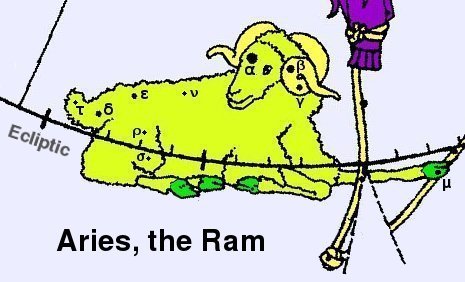 |
But there is also another strong witness of the time of day of Rachel's birth. If born after noon, then the star day of Rachel's birth on the Uniform Star Calendar (US) would have been Pincer (Alkamasha, σ Lib, Sig Lib), being the first star in the constellation of the Scorpion (1 Sco). It turns out that the day of the Virgin Mary's death was also on 1 Sco (US)! Thus, here we see another very rare and strong witness of a link between Rachel and Mary! This leaves no doubt of the time of Rachel's birth.
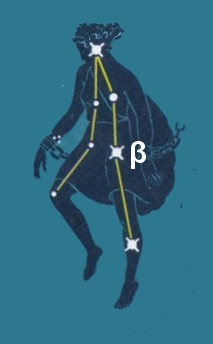 |
Isn't that amazing? Leah is linked to Sarah and Rachel to her son Joseph and the Virgin Mary on their star days of birth and yet they might have only been born a few minutes apart!
The evidence that two of Leah's children were twins is right in Genesis and yet so subtle that it has not been noticed before my work as far as I know. For all of the other children we are told that the wife conceived and that she then gave birth. In the case of her only daughter Dinah, it does not say that Leah conceived again (Gen. 30:19-21)! That is the evidence! If one believes Genesis was written by Moses then that could have merely been an oversight. But if one believes Genesis is a revelation from God, then it means that Zebulon and Dinah were twins!
 |
Until now, it has just been assumed in my work that Zebulon just had to put up with all of this feminine symbolism because, after all, Dinah was the only daughter and perhaps should be given extra respect. But now a different possibility arises. Before noon the star day of their birth was on the star Shofar (Sheratan, β Ari; Bet Ari) on the star day 17 Ari (see Figure 6). Note that it is only two days after Rachel's star γ, meaning that the sun appears to travel that far around the black circle (ecliptic) in two days. Because each of the twelve sons of Jacob represented a zodiac constellation and because Zebulon represented the Ram, it would make sense for his star to be a major star in the Ram. That star is the second brightest one of the three that are most easily found (α, β, γ) to see the constellation in the sky.
 |
Another possible star day link between Dinah and Leah is that in life Leah was the mother of Dinah, but in the myths, the Princess (star of Leah) was the daughter of the Queen (star of Dinah). There seems to be no end to the depth of the symbolism!
Thus, it is concluded that Zebulon was born on the star day Shofar, being born before noon and that Dinah was on the day Queen, being born after sunset. It turns out twins can often be born hours or even days or weeks apart, so there is no problem with a few hour between their births.
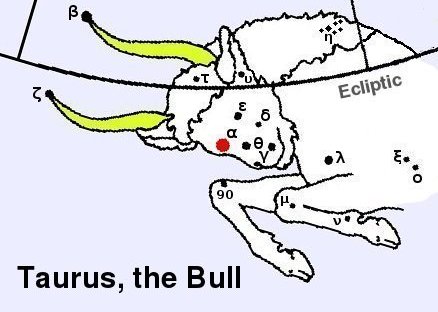 |
Now there are two more strong witnesses of the correctness of their birth date which comes directly from the prophecy of Moses about Joseph. He prophesied that Joseph was like a wild ox (a now-extinct bull with long forward pointing horns translated in the King James Bible as "unicorn") who would receive blessings on his head. He compared his two sons Ephraim and Manasseh to the two horns of the wild ox who would someday gather the people (Deut. 33:16-17).
Simply looking up the star days for the already published date of the birth of the twins, it is seen to fall on the day of the star θ Tau (Theta Tau) in the Hyades, right next to the star representing Joseph, α Tau (Alpha Tau, Aldebaran, the bright red star named "The Seer" in my work because it is the right eye of the Bull, representing a seer). It is also the star representing Joseph Smith the Seer.
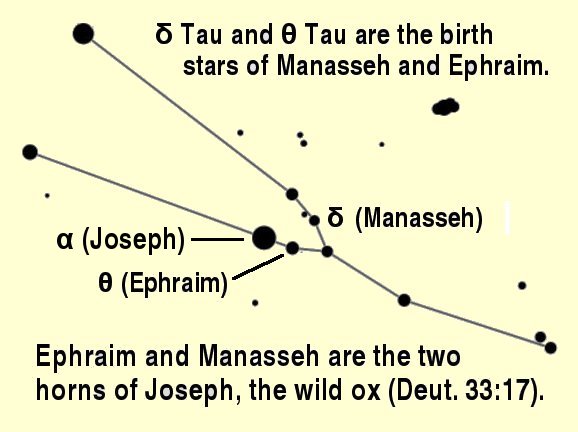 |
This brings us to the question of the names of the Hyades. One Greek tradition said they numbered five, which indeed is the number of the brightest members of the grouping. They were said to be the half sisters of the seven Pleiades, all being the daughters of Atlas. Modern astronomers have assigned the seven known names of the Seven Sisters (Pleiades) to them without actually knowing which was which. We call the brightest one Alcyone but more likely that one should be called Maya, who was the leader of the group. But we moderns have refrained from any attempt to attach the ancient Greek names of the sisters to the Hyades, partly because the ancient lists of names do not even agree with each other.
Two of the Hyades have modern proper names not taken from the ancient Greek sources. The bright one Aldebaran has the Arabic name meaning "Follower" and the other eye is named "Ain" from the Arabic for "the Bull's Eye". That leaves the other three that could still be given names of the original sisters.
One of those names now seems certain, provided that they came from an accurate ancient source. In my work it appears that the most likely source of much of our knowledge of the Greek traditions came from Pythagoras who was a priest in an Egyptian temple and brought a celestrial globe back to Greece. At least one Greek source says that the name of one of the Hyades was "Ambrosia".[5] That was their word for the "food of the gods".[6]
It turns out that the morning on which the manna ceased to be provided to the Israelites occurred on the star day of θ Tau (Theta Tau, Ephraim's star).[7] That manna certainly was food provided by God and is a possible source for being the origin of the ambrosia myth. Thus, it is here proposed that the Greek name for θ Tau be "Ambrosia" and that the English name be "Manna".
A second witness that "Manna" is a good name for θ Tau is that the Exodus also began on the star day Manna! The journey would have begun after noon on Thu 9 Apr 1462 BC because they all took booty of gold and silver and supplies as well as flocks and herds with them. It would have taken all morning to prepare after the Pharaoh's command had been given, allowing them to leave had been given. This means that another way to measure the "forty years" in the wilderness would be to count star years from the very day of the Exodus to the day the manna ceased! Thus, "Ambrosia" and "Manna" are almost certainly the correct names for this star.
As for the other two Hyades, most ancient Greek sources agree that one of the Hyades was named Eudora, which is Greek for "Good Gift". That sounds like a good name for Manasseh's star δ Tau (Delta Tau).
Most lists also agree that Koronis was another of the Hyades women, so in my work it is now the name of the first of the Hyades that the sun comes to annually, being γ Tau (Gamma Tau). Thus, the English name is "Hyades" as she can represent the entire cluster.
The birth dates and times of three sets of twins from the times of the Biblical patriarchs have been discussed. Evidence was presented that Leah & Rachel, Zebulon & Dinah, and Manasseh & Ephraim were all born on the days already published, with the first twin being born before noon and the second after noon resulting with them being born on separate meaningful star days.
Names for three of the the previously unidentified Hyades stars were proposed from the original Greek names from mythology, with the most certain being "Ambrosia" for θ Tau because it can be identified with "Manna" and the Exodus began and ended on that star day.
It was also proposed that there is a Star Calendar counterpart to Passover which is a week long holy period as the sun appears to pass two fairly bright spring stars. These two stars may be in the Twins, the Bull, the Ram or the Fishes depending on the year, due to precession.
Thus it has been shown that the Star Calendar can have an important use for birth dates, even to the assigning different stars to twins. All of these form a powerful witness from the Great Clock of the Creator!